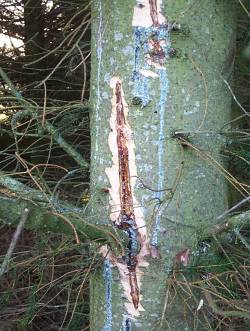Summary
Summary and conclusions

In May 2004, extensive damage was reported on pole stage and older Sitka spruce along the Dee valley in north-east Scotland.
Three affected sites were assessed in detail between 2004 and 2006 to determine the cause of damage and monitor its development. From this assessment it was concluded that drought during 2003 was the most likely cause of the damage to the Sitka spruce based on the symptoms and timing of damage.
A pathogenicity study of an unidentified species of Phomopsis that was isolated consistently from the margins of lesions concluded that the Phomopsis sp. is most likely to be an opportunistic invader of drought-damaged tissue of Sitka spruce rather than a primary pathogen.
Symptoms
Dead trees tended to be grouped, and by 2006 mortality averaged 22 % across the three sites.
Symptoms on surviving trees included varying degrees of top dieback, resinosis, and the formation of elongated lesions on stems and branches (see photo).
Shoot growth of surviving trees was notably lower during 2004 and 2005 than in previous years.
Rainfall in the Deeside area during 2003 was exceptionally low for a prolonged period from June until November, with soil moisture deficits of 200 mm or above for four consecutive months.
Pathogenicity study
An unidentified species of Phomopsis was isolated consistently from the margins of lesions (see photo), and from stained wood associated with lesions, on stems and branches of drought-affected Sitka spruce. This is the first record of this fungus being isolated from Sitka spruce.
The genus Phomopsis contains many species, many of which are known pathogens on a range of tree hosts. The fungus isolated in this study appears to be identical (based on ITS sequence data) to a species of Phomopsis isolated from damaged Norway spruce seedlings in Norway and subsequently found to be non-pathogenic when inoculated onto seedlings of Norway Spruce.
In this study the pathogenicity of the Phomopsis sp. was tested on young, potted Sitka spruce with and without moisture stress in experiments carried out during the summers of 2007 and 2008.
Small lesions associated with bark cracking developed on some trees inoculated with the fungus, but these lesions did not extend and subsequently healed. Lesion development was not affected by the water stress treatments applied to the host.
The Phomopsis sp. was re-isolated from several inoculated trees and DNA of the fungus was amplified using real-time PCR in xylem and phloem of inoculated but asymptomatic Sitka spruce trees up to 5 cm below the inoculation site eight months after inoculation. This showed that the fungus had established within the tree tissues following inoculation without causing disease symptoms.
Contact
For further information contact:
